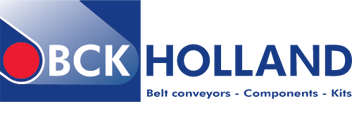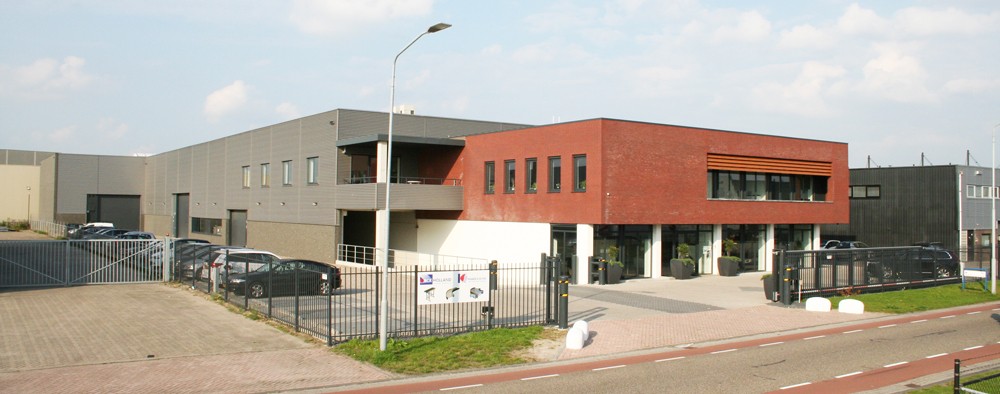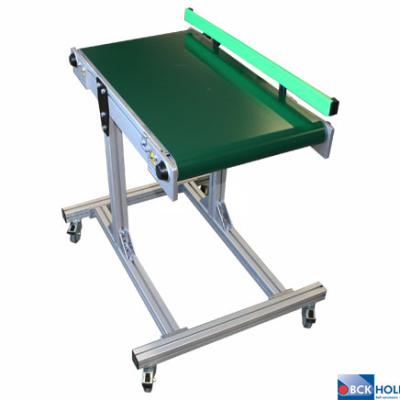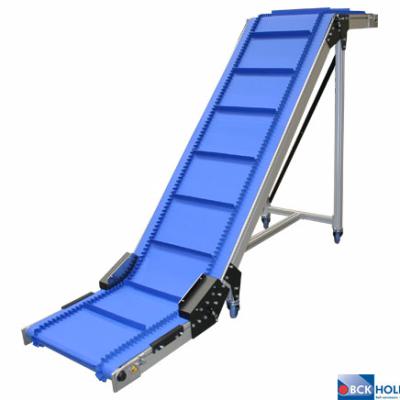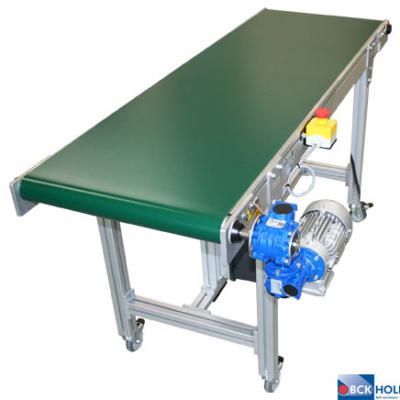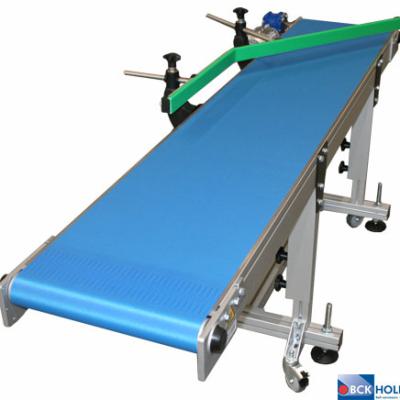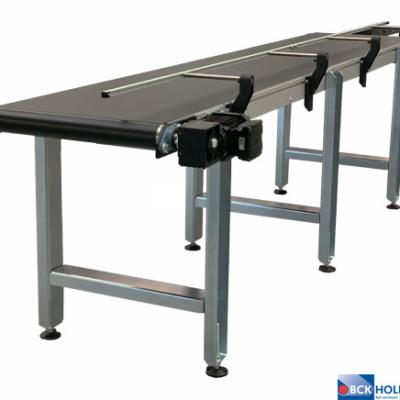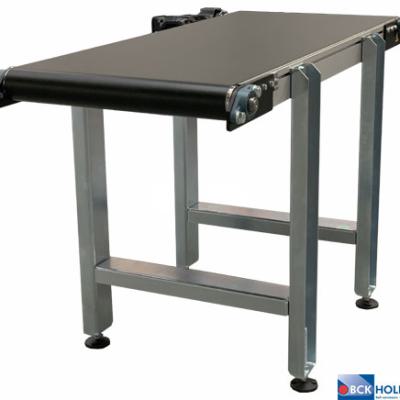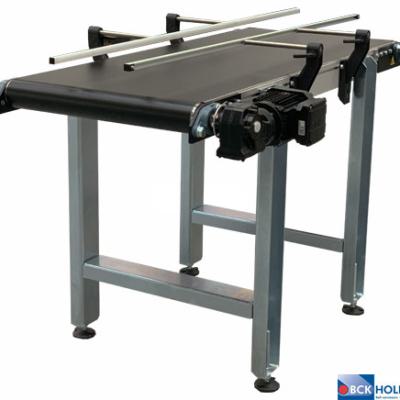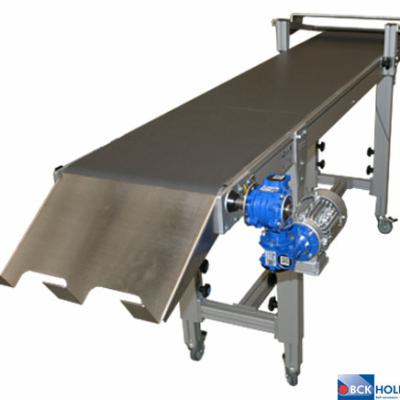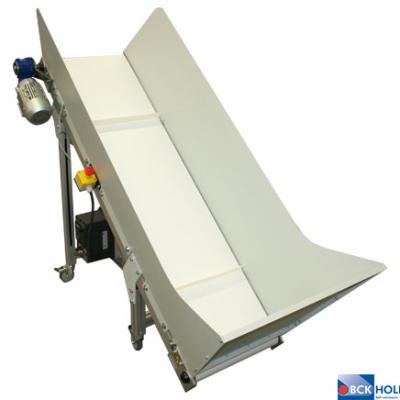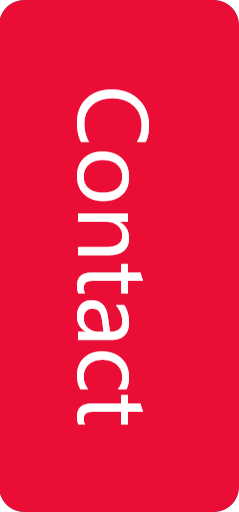Glossary
A complete list of commonly used industry terms and their definitions. For further questions or information, you can always contact contact us.
Drive roller
The drive roller is the roller on which the drive takes place. The roller can be made of different materials or used with additional coatings.
Drive
There are 4 options, namely: direct final drive, indirect final drive, direct central drive and indirect central drive.
Pressure belt
2 Belt conveyors positioned one above the other whereby the gap between the two becomes narrower. The upper belt conveyor presses on the product.
Powered brush
A powered brush is used to clean a belt material or chain material during production. For sharp products, a powered brush is often chosen instead of a scraper.
Accumulate / accumulation
Another word for heaping up and piling up. It is a technique for buffering products in which a transport system keeps running continuously.
Acetal (POM)
Acetal, the English word for polyacetal and also known as Polyoxymethylene (POM), is a polymer that mainly has an industrial application due to its hardness. The material is used in chain material, sprockets and pins, among other things.
Actuator
An actuator is described as an electrically controlled cylinder.
Aluminium profile
When an aluminum billet is pressed through a mold (extrusion), an aluminum profile is created. This profile is anodized after extrusion. BCK has a number of its own profiles with a unique T-slot where a standard hexagonal nut can be tilted into the profile from the outside.
Article code
BCK coding for relevant component/article.
Assembly system
A system or system for assembling parts.
Path width
The track width indicates the width of a gravity roller conveyor or driven roller conveyor, but is independent of the frame width.
Band accessories
Band accessories is a term used to indicate whether a specific accessory is used on a belt material. Think of cleats, wave edges, control belts, spill edges, belt coverings, trapezoidal belts, block belts, type of belt weld.
Band load
The weight that is placed on the relevant transport system. Usually belt load is indicated with kg/meter or total load.
Bandwidth
The tire width indicates the width of the belt material or chain material, but is independent of the frame width.
Tape material
A belt conveyor transports products over a belt material, also called (tread/cloth, round cloth/mat). The properties of a belt material determine the application in which they are used.
Belt scraper
Belt scrapers are used to clean belt material or chain material during production, often occurring in the food industry.
Belt conveyor
A moving endless belt for the transport of material or goods. Synonyms for belt conveyor are: belt, loading belt, conveyor belt, conveyor belt, conveyor belt, conveyor belt, transport system, treadmill, sorting belt, assembly belt, checkout belt, track, elevator, elevating belt, articulated conveyor, Z-conveyor, roller belt, running roller belt, roller belt, etc
Belt conveyor type
A belt conveyor runs either straight or in a curve in connection with tracking/steering the belt material. The straight sections are the N60, N114 or mini belt conveyors with their own type designation. The bends are normally specified based on tire width, angle and radius.
Curving belt conveyor
A belt conveyor that transports products around the bend at an angle. The angle in which the curved belt conveyor must convey can be freely determined.
Bulging
With a belt conveyor, convex rollers can be used to track a belt material.
Bracket
Bracket is the English word for mounting plate. Leg mounting brackets are used to mount an undercarriage to the transport system frame and side guide brackets are used to mount a side guide to the transport system frame.
Bridge construction
Bridge constructions are used to bridge static setups by means of an aluminum construction. Spaces can be available at all times without stopping a production line.
Buffering
Technique in which products are stored in a buffer before they are needed or processed. Depending on the available space, you can opt for a linear buffer system, buffer tables / turntables and use the height.
Bunkerband
A belt conveyor on which a funnel (bunker) is mounted into which products can be dumped. The belt conveyor then gradually empties this funnel by discharging the products.
Chain drive
Type of driven roller conveyor where the rollers are driven by a chain from roller to roller or by means of one central chain.
Chevron profile
The chevron profile on a belt material consists of several rows of cleats which are welded to the belt material at an angle.
Down time
Down-time is an English term used to indicate the period during which a system is unavailable. The term down is often used when a system cannot be reached temporarily, due to maintenance or other reasons.
DR module
A module developed by BCK Holland with which a transport system can be designed by simply answering a number of questions.
Carrier roller
A carrier roller is used in a gravity roller conveyor.
Dranger
A closer is mainly used on stainless steel buffer tables and stainless steel supply tables. The closer is mounted on the outer edge or above the stainless steel turntable to push/slide products to the outer edge or center of the table.
Drive Shaft
Type of driven roller conveyor where the rollers are driven by a long shaft by means of a PU belt. This shaft is mounted under the rollers.
Effective width
The effective width of a belt material, chain material or the associated belt conveyor or chain conveyor indicates which width can be used. If there is a kink or bend in the transport system, a guide may be required that removes the effective width, this also applies to belt or chain accessories.
Elevator
An elevator, also known as an elevator belt or Jacob's ladder, is used when bulk goods need to be transported upwards. An elevator usually has carriers and sometimes also corrugated edges that ensure that the goods deposited on the belt do not roll or slide down. Often a stainless steel input and/or output hopper is also placed on the belt conveyor in which the products are collected and/or stored.
Endstroke
A roller or plate at the end of a belt conveyor, chain conveyor, gravity roller conveyor or powered roller conveyor to stop a product.
Endless welding
The endless welding of a belt material ensures that a completely closed belt is created. The type of weld is determined by the roller diameter of the conveyor system.
Etage tape
A tier belt consists of several belt conveyors mounted above each other in the same frame.
F-trill black
A drive roller can be covered with black rubber. Covering driven rollers to provide extra grip to a belt material on a belt conveyor.
FDA
The Food and Drug Administration (FDA) in the United States of America is an agency of the federal government that monitors the quality and safety of food, additives and medicines, as well as the treatment of blood, medical products, devices with electromagnetic radiation and cosmetics. The FDA enforces portions of the Public Health Service Act.
Fix nut
A fix nut is a square nut with a small spring plate. These nuts can be fitted laterally in the profile of BCK and they remain in their position thanks to the spring-loaded plate.
Flat Top
Type of modular belt / chain where the surface is completely closed.
Flexible coupling
A flexible coupling makes it possible to link axes to each other.
Flush Grid
Type of modular belt / chain where the surface is partly open.
Frequency drive
A frequency converter (frequency converter, speed controller, frequency controller or simply drive in the jargon) is an electronic circuit that is able to change the frequency of an applied signal while the voltage varies and the torque is maintained. Variable speed drives are usually used to control the speed of a three-phase asynchronous motor by changing the frequency of the rotating field. The controller can also be used as a starting device.
Fusing Band
A merge belt or merge conveyor is used to merge multiple lines. The most common angle of the fuser belt or merge unit is approximately 30° and 45°.
Forced cooling
Forced cooling is a separate component for motors that continuously cool the motor by means of cooling. a fan.
Vulcanized Drive Roll
A drive roller can be vulcanized with rubber. Vulcanizing drive rollers is used to provide extra grip to a belt material on a stainless steel belt conveyor in the food industry.
Wave Edge
A corrugated edge is a corrugated piece of tire material that is welded at right angles to a tread or by means of hot air. This wave edge ensures that a (bulk) product remains on the tread. The pitch of the corrugations and the height of the corrugated edge determine the roller diameter of a belt conveyor.
Grip module
A grip module is a link of a modular belt / chain on which there is a rubber layer for extra friction. A modular belt / chain with grip modules can lift a product where a normal modular belt / chain is too slippery.
HACCP
HACCP, the abbreviation for Hazard Analysis and Critical Control Points, is a risk inventory for foodstuffs. The Dutch translation is: Hazard analysis and critical control points. Companies involved in the preparation, processing, treatment, packaging, transport and distribution of foodstuffs must therefore identify all aspects of the production process and analyze them for hazards. This control process, initiated by the European Union, aims to ensure that the production process of all foodstuffs involves as little risk of contamination as possible.
Harmonica roller conveyor
A harmonica roller conveyor is an extendable roller conveyor that is used in flexible workplaces. Harmonica roller conveyors are often used, for example, when unloading trucks or transporting boxes to a shutter. Synonyms for harmonica roller conveyor are: flexible roller conveyor, scissor roller conveyor, folding roller conveyor, etc.
Harmonica wheel track
A harmonica roller conveyor is an extendable roller conveyor that is used in flexible workplaces. Harmonica roller conveyors are often used, for example, when unloading trucks or transporting boxes to a shutter. Synonyms for harmonica roller conveyor are: flexible roller conveyor, scissor roller conveyor, folding roller conveyor, etc.
Hold down tabs
A hold down tab is an option for modular belts / chains. It is a special link that ensures that the modular belt / chain remains on the frame, so that it does not rise during bends in the outer radius, for example.
Installation dimensions
Built-in dimensions occur if a transport system has to be placed around other equipment. The transport system can be a belt conveyor, chain conveyor, roller conveyor or driven roller conveyor. The most important dimensions are often the installation width, installation height and installation length.
INOX package
Stainless steel package consisting of various options to select an alternative choice of material for different components. In general, the bearings, shafts and mounting materials can also be made of stainless steel.
IP value
The IP value indicates the touch protection of live parts and the tightness of the housing against dust and water.
Return roller
The return roller on a belt conveyor is the roller on the opposite side of the drive roller.
Turning station
A turning station is generally a stop for turning products. The stop can be made of different materials and exist in different shapes. A reversing station can be used with belt conveyors, chain conveyors, gravity roller conveyors and driven roller conveyors.
Reversing wheel
A return wheel is used between 2 systems that are perpendicular to each other. The reversing wheel ensures that the products do not fall between the transport systems. A reversing wheel can be used with belt conveyors, chain conveyors, gravity roller conveyors and driven roller conveyors.
Chain Accessories
Chain accessories is a term used to indicate whether a specific accessory is used on a chain material. Think of cleats, sideguards, side taps, side wings, hold down taps, grip top modules, etc.
Chain material
A chain conveyor transports products over a chain material also called (tread/mat/plastic links, ). The properties of a chain material determine the application in which they are used.
Ball table
A ball table consists of a sheet material with recesses for ball transfer units. Light, medium and heavy products can be manually transported in all directions on the ball transfer units.
Bearing plates
The bearing plates of conveyor systems are often seen as the end plates of a system. They owe their name to the bearings that are mounted in front of the drive shaft or reversing shaft. In addition to the standard bearing plates, which already have recesses for knife transfers, they can also be machined. Chamfering and/or completely rounding off bearing plates reduces the transition between 2 systems.
Laminop
Laminop is a type of covering for the drive roller of a belt conveyor. Laminop has a rough surface structure due to its studs. By coating a drive roller with laminop, the drive roller gets more grip on the belt material and the conveyor system can transport more load.
Lateral transport system
In a lateral transport system with belt material or chain material, the product is not carried but transported "on the side". Lateral belt conveyors or chain conveyors can be designed as single or multiple.
Tread
Top side of the belt material.
Longitudinal groove structure
A belt material can have a longitudinal groove structure as the top layer. The top layer has a "ribbed" structure with a very high friction. This keeps the dirt superficial but between the ridges.
Light box
A light box is a component used to make an easy combination between a belt conveyor and vision system. By using a translucent band material, a silhouette/shadow can be created from a product. A vision system can check the contours and take action.
Conveyor belt
A conveyor belt usually refers to a system in a factory in which the products in the making are guided on a belt past the employees, who each perform certain, repetitive actions on them. Synonyms for conveyor belt are: belt, belt conveyor, conveyor belt, conveyor belt, conveyor, conveyor belt, conveyor system, treadmill, sorting belt, assembly belt, checkout belt, track, etc.
Mechanical connector
Type of connection in a tape material. Also called zipper. A mechanical connector in a belt material is often used if a belt material has to be changed frequently and quickly.
Drivers
A carrier is an option that can be welded or glued to the running surface of a belt material that is mainly used to carry products when the conveyor system is mounted at an angle. A cleat is often a plastic extrusion, but can be made from several layers of belt material, which is called a fabric-reinforced cleat.
Multi-track tape
A belt conveyor or chain conveyor consisting of several tracks placed next to each other in the same frame with one drive.
Multi-way tracks
Multi-way conveyors are gravity roller conveyors where the rollers can rotate in multiple directions. The rollers mounted in the multi-way track are also called omni rollers or multi-way rollers.
Mess Takeover
A knife takeover is a "sharp" / small transition on the input or output side of a conveyor system. A blade transfer is required when transporting small products that will not be dumped tomorrow. A distinction can be made between a fixed blade and a bearing / rolling blade.
Mini belt conveyor
A "mini" belt conveyor owes its name to its built-in dimensions. With small roller diameters and (often) completely integrated motor, it is very suitable for smaller spaces.
Modular chain conveyor
The modular chain conveyors (also called mat top conveyor, Intralox conveyor or chain conveyor) are conveyor systems with a modular belt / chain as running surface. With this maintenance-friendly transport system, curves and straights can be combined in one modular chain conveyor.
Moss rubber
Moss rubber is a type of coating for drive rollers, gravity rollers, toothed belts, gravity wheels or belt material for soft contact with a product to make it rotate or clamp.
Negative kink
A transport system has a negative kink if an inclined part (from bottom to top) changes into a flat part.
Negative pyramid structure
A belt material can have a negative pyramid structure as a top layer (abbreviation NP). The top layer has a structure where the tip of the pyramid shape is pressed into the belt material.
Nitrile Butadiene Rubber (NBR)
Nitrile butadiene rubber (NBR), or nitrile rubber for short, is an elastomer, a synthetic polymer obtained by the copolymerization of acrylonitrile and butadiene. In addition to PVC and TPU, NBR is also available as a tread.
Omnidirectional
Transportable in all directions.
Chassis
The undercarriage is on which a transport system can be mounted. The undercarriage is often standard, but can also be custom constructed to meet all requirements. The choice of material for the bases can varyëfor the different environments and industryën.
Support Role
A support roller is used with both aluminum belt conveyors and stainless steel belt conveyors to keep the return side of the belt material as high as possible in the frame. In doing so, we reduce the chance of contamination on the return part and we prevent the risk of jamming when people are working on the belt conveyor.
Put-on motor
A combination of a motor and a gear unit where the gear unit has a hollow shaft so that it can easily be slid onto a drive shaft.
Orientation and feeding system
A system or system that ensures that bulk products with the same orientation come out of the system and are then supplied to, for example, an assembly system.
Transition axis
A transition shaft is placed between 2 rollers of a conveyor system to make a transition smoother. If products are smaller than the distance between 2 systems, it can get stuck or change orientation.
Transition image
A transition plate is placed between 2 rollers of a transport system to make a transition smoother. If products are smaller than the distance between 2 systems, it can get stuck or change orientation.
Transition Role
A transition roller is placed between 2 rollers of a conveyor system to make a transition smoother. If products are smaller than the distance between 2 systems, it can get stuck or change orientation.
Pick & place system
A system or system that picks up products and places them in a different position. This system is often used in an assembly system.
Polyamide (PA)
Polyamide (PA) is a polymer that mainly has an industrial application because of its hardness. The material is used in chain material, sprockets and pins, among other things.
Polyethylene (PE)
Polyethylene (PE) is a polymer that mainly has an industrial application because of its hardness. The material is used in chain material, sprockets and pins, among other things.
Polygon effect
The Polygon effect is created by pulling the chain material over the sprocket of the chain conveyor. Because the pin and link pass over the sprocket, there can be a change in the linear velocity. The pin moves across the diameter of the sprocket as the module tries to traverse a smaller radius due to vertical movement/vibration. Naturally, this effect is greater with smaller roll diameters than with larger roll diameters.
Polyoxymethylene (POM)
Polyoxymethylene (POM), also known as polyacetal, is a polymer that mainly has an industrial application due to its hardness. The material is used in chain material, sprockets and pins, among other things.
Polypropylene (PP)
Polypropylene (PP), also known as polypropylene, is a thermoplastic polymer that has a very wide application. The material is used in chain material, sprockets and pins, among other things.
Polyvinyl chloride (PVC)
Polyvinyl chloride (PVC), chemical name polychloroethene (PCE), is a widely used thermoplastic that is created after polymerization of the monomer vinyl chloride (vcm). Because PVC is cheap and easy to process, it is widely used in all kinds of industries to replace wood and concrete, among other things. There are many different PVC belt materials available with various colors and surface structures.
Positive kink
A transport system has a positive kink if a flat part changes into a sloping part (from bottom to top).
Pusher
A pusher is used to orient a product or change lanes. A pusher can be controlled both pneumatically and electrically.
Brake clutch combination
A brake clutch combination is used for belt conveyors that have to stop at high accuracy. The component clamps the drive shaft while the engine continues to run.
Brake motor
Motor equipped with brake which can be controlled separately.
Robot system
A system or system in which robots trade products.
Roll diameter
The roll diameter is a name to indicate the size of a roll (indicated in mm).
Roller track
A conveyor system based on rollers mounted at a certain pitch to transport products. A roller conveyor can transport products by gravity as well as driven by motors or belts (the driven roller conveyor). Synonyms for roller conveyor are: roller conveyor, roller conveyor, roller conveyor, gravity conveyor, etc.
RollerDrive
Type of driven roller conveyor where the rollers are driven by various motor rollers.
Roller Top
Type of modular belt in which rollers are integrated so that, among other things, products can accumulate.
Routing
Routing gives a specific path to a product based on conditions from a parent system. There is a routing if products have different start and end positions.
Stainless steel turntable
Stainless steel turntables are a construction with a rotating blade and are usually placed in a hygienic (or humid) room at the end of a production process for buffering products. It also sometimes happens that the stainless steel turntables are placed at the beginning of a production process to supply jars, cans, bottles, etc. to a filling line. Synonyms for stainless steel turntable are: stainless steel buffer table, stainless steel supply table, buffer system, INOX turntable, etc.
Shooting band
By working at different speeds, a product can be "shot" at right angles to another transport system. The orientation of the product does change.
Segment conveyor
A segment conveyor is a type of modular conveyor system in which the running surface is made up of segments (coxtrusions) that are pressed together. Specially developed for the textile industry with a completely closed surface without a length - width ratio.
Separation
Separation is the creationëof a horizontal or vertical space between products.
Side Guards / Side Wings
A side guards / side wings is an option for modular belts / chains. It is a special link that is mounted perpendicular to the tread and ensures that the product remains on the modular belt / chain, for example when transporting bulk products.
Sleeve
Sleeve is a covering for rollers (loosely translated as a "sleeve"). The sleeve can be produced in different materials with corresponding properties. With driven roller conveyors and gravity roller conveyors it often occurs to prevent damage to products.
Slipstick
The so-called slipstick effect can occur when starting up a long modular chain conveyor. Slip-stick is called the phenomenon (sometimes also called Stick-slip) that when two objects slide over each other, a jerking movement sometimes occurs spontaneously.
String conveyor
A belt conveyor uses round or V-belts to transport products. This technique is very common in the printing industry.
Tracks
The "straightening" or steering of a tape material is largely created by tracking a tape material. By using a strap material to track, you prevent a strap material from running off the frame. Tracking of a belt material can be done by bulging rolls or using aids (such as a belt accessory). .
Sprockets
Sprockets are sprockets used to drive modular belts / chains.
Stopper
A stopper can be installed on various transport systems that can be controlled electrically, pneumatically or manually. A stopper often serves as an interruption of the product flow if a next component in the line fails, to create separation between products or to bundle products.
No accumulation pressure
Buffering method in which the products do not push each other.
System
A coherent whole of components that serve the same purpose.
Toothed belt conveyor
A timing belt conveyor uses a timing belt, a wide variety of materials, to transport products. Synonyms are timing belt, belt conveyor, etc.
T-slot
Slit on the side of an aluminum profile in which nuts can be placed to fix, for example, side guides, undercarriage, photocells, etc.
Teflon (PTFE)
Polytetrafluoroethylene (PTFE), Teflon is an ethylene polymer in which all hydrogen atoms have been replaced by fluorine (haloalkene). Due to its high heat resistance and low friction surface, it can be used in belt conveyors that transport hot products and used for low-friction lateral guidance over transition plates.
Backstop
A backstop is an optional component in, for example, a drum motor. With increasing functions, dangerous situations can arise in emergency stop situations if the belt returns when the belt should actually remain stationary. The backstop prevents the reel from spinning.
Thermoplastic Polyurethane (TPU)
Thermoplastic Polyurethane (TPU) is a class of polyurethane that has many applications due to its elasticity, resistance to oil, grease and abrasion. Many tire materials have a TPU tread.
Transfer system / unit
Transfer system or transfer unit is used when transferring products from system to system. The Transfer unit can consist of timing belts, rollers or chain material.
Funnel
Often a stainless steel construction to receive products or to guide them to another destination.
Trough shape
A belt conveyor can be mounted in a light trough shape. The sliding plate of the belt conveyor is set at an angle, so that the side walls are higher than the middle of the belt. The trough shape is common in bulk transport.
Drum motor
A drive roller in which a motor is integrated.
Align
Product alignment generally refers to the orientation of the product relative to its width on the conveyor system. If products arrive at different starting points and require the same output position, the products must be aligned to éénn side.
Vision system
A system or system that determines which handling must be performed by means of a camera system.
Work table
Work tables are common in assembly lines where products to be assembled must be transported. The choice of material determines the environment in which the table must function.
Side guide
A material mounted on a track frame of a belt conveyor, roller conveyor, chain conveyor, driven roller conveyor to guide products over and/or onto the track.



